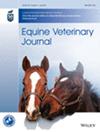Yearling laryngeal function grades II.2 and below are not associated with reduced performance
Abstract
Background
The relationship between Thoroughbred yearling laryngeal function (YLF) grade and race performance is unclear.
Objectives
To determine the effect of YLF on future race performance.
Study design
Retrospective cohort study.
Methods
Post-sale endoscopic recordings were reviewed from Australian yearling sales in 2018–2019. Race performance was evaluated for career and as 2-, 3- and ≥4-year-olds. Multivariable generalised linear modelling examined the association between YLF and performance, with risk estimates presented as coefficients (95% CI).
Results
The YLF in 5175 examinations was graded I in 29.8% (n = 1542); II.1 in 49.0% (n = 2537), II.2 in 16.5% (n = 855), III.1 in 3.9% (n = 200), III.2 in 0.8% (n = 39) and III.3 in <0.04% (n = 2). Additional endoscopic abnormalities included ventroaxial luxation of the corniculate process (VLAC, n = 77, 1.5%); arytenoid mucosal lesions (n = 392, 7.6%) and intermittent dorsal displacement of the soft palate (iDDSP, n = 1264, 24.4%). Median (IQR) career earnings were: grade I $45 095 ($15 565, $113 220); grade II.1 $45 315 ($15 915, $107 490), grade II.2 $38 610 ($14 326, $95 218), grade III.1 $32 765 ($8565, $86 030) and grade III.2 $35 810 ($3700, $65 770). There was no difference in career earnings for YLF grades II.2 and III.1, compared with referent grade I/II.1, whereas grade III.2 earned less overall (−$46 015 (95% CI: −$89 994, −$2036), p = 0.04). Earnings in ≥4-year-olds were less for grades III.1 (−$35 076 (−$56 129, −$14 024), p = 0.001) and III.2 (−$53 219, (−$76 062, −$30 375) p < 0.001).
Main limitations
Lack of follow-up data due to retrospective nature of study. Exclusion of unraced horses and those with no prize money from analysis.
Conclusions
Ninety-five percent of the yearling population had grades I, II.1 or II.2 YLF and minimal difference in race performance was identified between them. Horses with grade III.1 YLF performed similarly to grades I/II.1 in their early careers but had reduced race performance at ≥4-year-old.


 求助内容:
求助内容: 应助结果提醒方式:
应助结果提醒方式:


